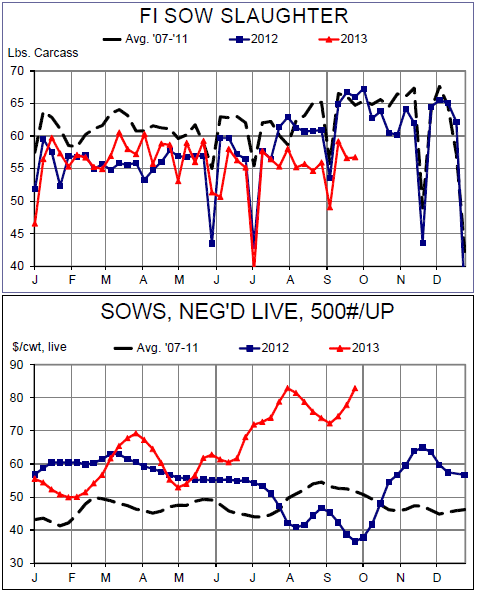



CME: US Sow Slaughter Flatlined Since July
US - While there is little or no current data being provided by USDA or other federal agencies, there are a few USDA websites that are still operative, according to Steve Meyer and Len Steiner.One of them is the USDA MPR (mandatory price reporting) Datamart at http://mpr.datamart.ams.usda.gov/. There is obviously nothing new on the site but there are some historical data through 27 September (and some through 30 September) available should you need it. Be a bit careful, however. We found that the file for current sales volumes of negotiated pork sales, FOB plant, contained the same numbers for both cuts and trimmings for every week since April. We don’t think things were quite that consistent. We are not sure what would cause that error but we are pretty confident that no one will be in the Des Moines office, where those data are prepared for publication, to fix it for the next few days.
And a couple of erratas. We stated last week that the CME Group Lean October Lean Hogs contract would close 15 October due to the observance of Columbus Day on 14 October. CME Group commodities markets are OPEN on Columbus Day, 14 October. Only foreign exchange and interest rate markets are impacted by the Columbus Day holiday so the October Lean Hogs contract expires on 14 October and open positions will be settled on 16 October. The critical day for USDA hog price data appears to be 15 October, the first day for which data will be needed to compute the CME Lean Hog Index on 16 October. Of course, a cash price before then could be useful!
We also stated last week that USDA had not yet published formula-based prices for wholesale pork cuts. Not true. USDA has been publishing those data on a weekly basis since the week ending 8 July. We can’t find a way to get to the reports themselves but the data are available at the Datamart website discussed above. Still to come from the mandatory wholesale pork system are reports for forward- priced pork cuts and export sales. When those are available, we should also see a comprehensive pork report that covers all sales of pork wholesale cuts. We have heard no definite timetable for those additional reports but the formula report came out six months after the new report for negotiated cuts began in January.
One reason for some pushback to USDA’s September Hogs and Pigs Report was the size of the breeding herd relative to recent patterns of sow slaughter and sow prices. Recall that the herd was estimated to be 5.814 million head, just 0.4 per cent larger than last year. Analysts expected the herd, on average, to be up 1.5 per cent which would have put it at 5.874 million head.
Meanwhile, US sow slaughter has basically flatlined since 1 July, a time of year in which it is normally trending upward. As with virtually everything else in the pork sector, we have to be careful comparing sow slaughter to one year ago since producers were unloading sows to reduce feed costs. But even comparing this year’s slaughter to the 5-year average (2007-2011 — a period that doesn’t even include last year’s big numbers) indicates that slaughter has been VERY LOW. Note that the last two weeks in the top graph below are based on sow purchases reported through mandatory price reporting.

Actual sow slaughter data runs two weeks in arrears even when USDA is operating! “Yes, but we are bringing fewer sows from Canada,” you might say — and you would be correct. But the 7.2 per cent reduction in the number of Canadian sows and boars coming south from 7/1 through 9/15 amounts to only 7,553 fewer animals versus 2012. The 7.4 per cent reduction in US sow slaughter amounts to 47,380 fewer animals than last year and just over 80,000 fewer than the ‘07-’11 average over that time period. One impact, of course, is RECORD HIGH sow prices. The first record was set in late July and last week’s $82.86/cwt. live for 500-lb. and over sows broke that record. $400-plus for an aged sow is a pretty big incentive to sell—-but apparently not as big as the prospects of $30-$40 per head profits in 2014.








